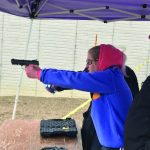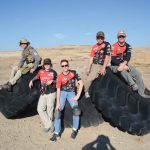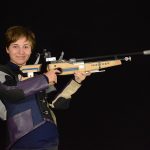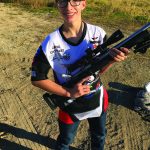SAFETY Vol 31 Summer 2018
Posted by Junior Shooters
 Juniors Get Safety!
Juniors Get Safety!
Juniors understand safety, but they need to be taught and reminded what to do. Let them know that they are also a safety officer when you are at the range. I recently received an email from a young 13-year-old who really gets it.
“Hello, my name is Turner. I am 13 years old, and I am a first-year sporting clays shooter in South Carolina. I have read the Junior Shooters Volume 30 Spring 2018 magazine with the article called ‘Starting Out Young.’ I really enjoyed the article. I 100% agree with your editor’s note. I participate in SCYSF shooting events where there may be almost 700 youth shooters. I appreciate the focus on safety for starting shooters like me. I feel confident being around that many young people carrying shotguns because we are all trained and consider safety first. This is a sport for all ages, and safety can be taught no matter how young or old you are.”
Safety Flags Are a Must
I see more ranges starting to require the use of safety flags. There are some matches that also require the use of safety flags. I wish all matches would.
I am very vocal about the use of safety flags. I think they should be used in all firearms, airsoft, paint ball, and BB guns – yes, ALL guns. When we teach juniors how to shoot, we must always emphasize safety. One of the problems is that even if you go over the ten main safe-shooting rules — which include: “A gun is always loaded” and “Never point the muzzle at anyone or anything you don’t want to destroy” and “Know what is behind your target” — people still don’t treat a gun with the respect it deserves. A gun is like an automobile; if you don’t take care of it, and don’t pay attention, bad things can happen. On the other hand, if everyone pays attention to what they are doing and follows the rules of the road, you can drive and enjoy the shooting sports your life.
So, how do safety flags relate to automobiles? Safety flags are like seatbelts — actually, they are even better. If a safety flag is used, then the gun cannot fire. If somehow (and it does happen all too often) a loaded round is in the chamber and the trigger is pulled, it cannot fire with a safety flag in it!

We tell the juniors who train with us that we want them to always use a safety flag. When they come to the range, their firearm should be in a case with a safety flag already in it. They take the case to a safety table along with a safety officer. The safety officer clears the firearm by physically looking to make sure the chamber is empty and there is no detachable magazine in the firearm and no rounds in a fixed magazine. The safety flag is then used to impede the action so it cannot close. The shotgun or rifle is then placed in the gun rack or on the shooting table with the flag in it, and the safety is ALWAYS ON! A pistol or revolver would follow the same procedure if it was to be put back in the case. If it is to be placed in a belt holster, then it would have to be cleared (taking the magazine out first), pointed toward the berm, pull the trigger to drop the hammer down, and the safety (if it has one) put in the ON position, and then holstered. NOTE: No magazines are allowed in the magazine-well except for the person who is actually up shooting after being told by the range officer to load the firearm and make ready.
On a firing-line range (more than one shooting position), all firearms should have the action open with a safety flag in them unless they are actually being fired right then. If the shooter gets up for even a minute from his shooting position, then a safety flag should be in the action.

Do you think I am being paranoid? Just remember, ALL shooting accidents would be prevented if a safety flag was in the action! Once the safety flag is removed, it is VITAL that all other safety rules are followed. You cannot take back a bullet and ask for a “do over” just as you cannot ask for a “do over” when someone goes through a red light. Stop the accident before it happens!

CAPTION HIGHLIGHT PARAGRAPHS:
Don’t have a safety flag? Then go into your shed or garage and pull out some of that colorful weed-eater string or a zip tie you may have. CAUTION: Do NOT put it in the barrel! It can easily go in the action, but when closing the bolt, let the bolt down SLOWLY!
Safety flags don’t have to go inside the chamber or barrel. In fact, putting plastic down a hot barrel is a no-no. It can melt and mess up the barrel. They do need to stop the action from closing and allowing a cartridge to fire. They should also be colorful so it is easy for a range officer to see them.
If a safety flag is blocking the action of the firearm, then it cannot fire! There are all shapes and sizes of safety flags, and they are available for revolvers, pistols, shotguns, and rifles.
Creedmoor
CLICK ON LINK ABOVE
https://www.creedmoorsports.com/


















Comments
Leave a Reply
Please note: Comment moderation is currently enabled so there will be a delay between when you post your comment and when it shows up. Patience is a virtue; there is no need to re-submit your comment.
You must be logged in to post a comment.